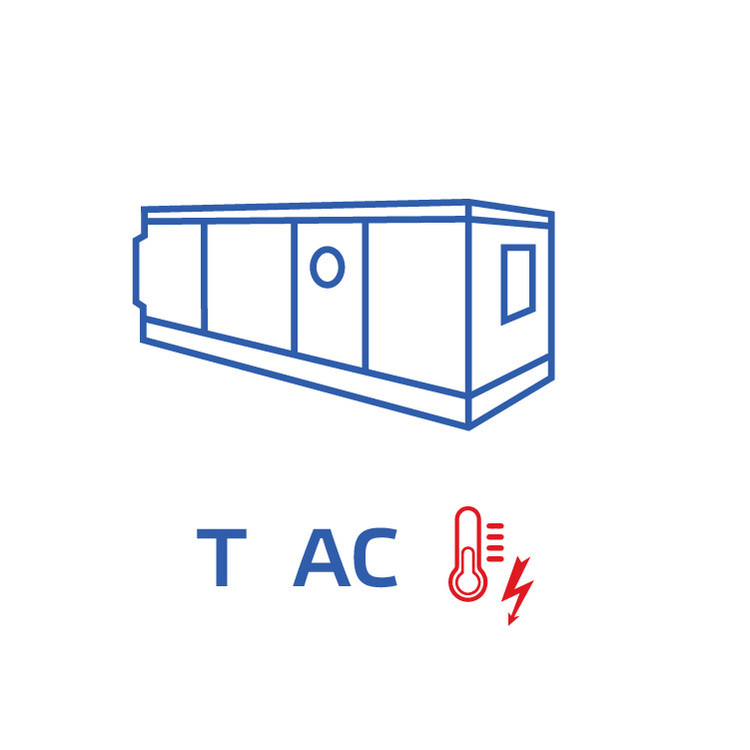Schematic overview
NOT FOR SALE YET-Temperature-based control | AC fan | electric heater
Solution description
State-of-the-art temperature-based supply-only air handling unit control. Fan with an AC 3-phase 400 V motor and maximum current 9,5 A. The AHU features a three-step electric heater. It has two levels of overheating protection. Differential pressure sensors are used to monitor fan operation and filter condition. Air damper actuator control.
Documents
Additional specifications and description
This solution is designed to monitor and control air handling unit that is shown on schematic below:

Air handling unit consists of four parts, which are: supply air damper (1), supply air filter (2), supply fan (3) and electric air heater (4).
Control logic description
Operation of air handling unit is automatic and based on sensor readings. There are predefined logics for the different parts of the AHU.
Supply air damper opens 30 seconds before supply fan starts. This is crucial for high airflow AHUs as it prevents possible damage to the air damper.
Air filter condition is measured via differential pressure transmitter HPS-M-1K0-2. The measurements are transferred to HVAC controller DRPUM (master device). In case the pressure drop on the filter exceeds the setpoint, user will be notified to perform their maintenance. However, the AHU continues its operation regardless of the filter condition.
Supply fan speed can be controlled manually or automatically via frequency inverter FI-E-44095E2. We also use differential pressure transmitter HPS-M-1K0-2 to control fan operation. In case of mechanical fan failure (jamming, bearing breakdown), there will be no pressure drop and the master device will produce the following steps: switch off frequency inverter, close air damper and inform the user about the error. In automatic mode HPS-M-1K0-2 can be used to maintain certain pressure difference.
Electric air heater operation is controlled using duct temperature and humidity sensor DSTHM-2 in combination with Modbus RTU IO module DIO-M-D4. If the measured temperature is higher, than the desired one, electric heater is switched off. Otherwise, if the measured temperature falls below the desired value, the first step of electric heater is activated. If the resulting temperature is still lower than desired one, the next step will start operating. When the resulting temperature becomes exceeds the desired value, the steps are switched off one by one. Electric air heater won't switch on if there is no certain pressure drop on the fan.
Electric air heater has two levels of overheating protection. One of them is triggered when the casing temperature reaches 60°C and it restarts automatically. The second level activates when the enclosure heats up to 90°C and can only be restarted manually.
To prevent overheating when the AHU switches off, it is conducted in the following steps:

Air handling unit consists of four parts, which are: supply air damper (1), supply air filter (2), supply fan (3) and electric air heater (4).
Control logic description
Operation of air handling unit is automatic and based on sensor readings. There are predefined logics for the different parts of the AHU.
Supply air damper opens 30 seconds before supply fan starts. This is crucial for high airflow AHUs as it prevents possible damage to the air damper.
Air filter condition is measured via differential pressure transmitter HPS-M-1K0-2. The measurements are transferred to HVAC controller DRPUM (master device). In case the pressure drop on the filter exceeds the setpoint, user will be notified to perform their maintenance. However, the AHU continues its operation regardless of the filter condition.
Supply fan speed can be controlled manually or automatically via frequency inverter FI-E-44095E2. We also use differential pressure transmitter HPS-M-1K0-2 to control fan operation. In case of mechanical fan failure (jamming, bearing breakdown), there will be no pressure drop and the master device will produce the following steps: switch off frequency inverter, close air damper and inform the user about the error. In automatic mode HPS-M-1K0-2 can be used to maintain certain pressure difference.
Electric air heater operation is controlled using duct temperature and humidity sensor DSTHM-2 in combination with Modbus RTU IO module DIO-M-D4. If the measured temperature is higher, than the desired one, electric heater is switched off. Otherwise, if the measured temperature falls below the desired value, the first step of electric heater is activated. If the resulting temperature is still lower than desired one, the next step will start operating. When the resulting temperature becomes exceeds the desired value, the steps are switched off one by one. Electric air heater won't switch on if there is no certain pressure drop on the fan.
Electric air heater has two levels of overheating protection. One of them is triggered when the casing temperature reaches 60°C and it restarts automatically. The second level activates when the enclosure heats up to 90°C and can only be restarted manually.
To prevent overheating when the AHU switches off, it is conducted in the following steps:
- The electric heater is switched off;
- The damper remains open, and the fan continues to operate for three minutes to cool down the air heater;
- The fan is switched off, and the air damper is closed.
System configuration
This solution includes network gateway DIG-M-2 that provides the user with the access to the online HVAC platform – SenteraWeb. The connection can be established via an Ethernet cable or a Wi-Fi network. It allows to remotely monitor data and adjust settings of the connected HVAC devices via internet. Data logging is also possible.
This solution includes network gateway DIG-M-2 that provides the user with the access to the online HVAC platform – SenteraWeb. The connection can be established via an Ethernet cable or a Wi-Fi network. It allows to remotely monitor data and adjust settings of the connected HVAC devices via internet. Data logging is also possible.


Remarks, reviews & ratings